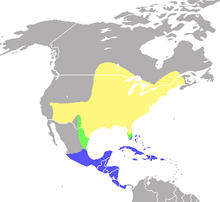
Back درسة نيلية Arabic Passerina cyanea AST Индигова пасерина Bulgarian Cardenal anyil de front lila Catalan Passerina cyanea CEB Papežík indigový Czech Bras goleulas Welsh Indigofink German Passerina cyanea Spanish Passerina cyanea Basque
| Indigo bunting | |
|---|---|

| |
| Male at Quintana, Texas, spring migration | |

| |
| Female | |
| Scientific classification | |
| Domain: | Eukaryota |
| Kingdom: | Animalia |
| Phylum: | Chordata |
| Class: | Aves |
| Order: | Passeriformes |
| Family: | Cardinalidae |
| Genus: | Passerina |
| Species: | P. cyanea
|
| Binomial name | |
| Passerina cyanea (Linnaeus, 1766)
| |

| |
| Range of the indigo bunting
Summer-only range Migratory range Winter-only range
| |
| Synonyms | |
| |
The indigo bunting (Passerina cyanea) is a small seed-eating bird in the cardinal family, Cardinalidae. It is migratory, ranging from southern Canada to northern Florida during the breeding season, and from southern Florida to northern South America during the winter. It often migrates by night, using the stars to navigate. Its habitat is farmland, brush areas, and open woodland. The indigo bunting is closely related to the lazuli bunting and interbreeds with the species where their ranges overlap.
The indigo bunting is a small bird, measuring 11.5–13 cm (4.5–5.1 in) in length. It displays sexual dimorphism in its coloration; the male is vibrant blue in the summer, with brightly colored plumage during the breeding season to attract a mate. It is brown during the winter months, while the female is brown year-round. Nest-building and incubation are done solely by the female. The diet of the indigo bunting consists primarily of insects during the summer months and seeds during the winter months.
- ^ BirdLife International (2018). "Passerina cyanea". IUCN Red List of Threatened Species. 2018: e.T22723951A132171198. doi:10.2305/IUCN.UK.2018-2.RLTS.T22723951A132171198.en. Retrieved 11 November 2021.
